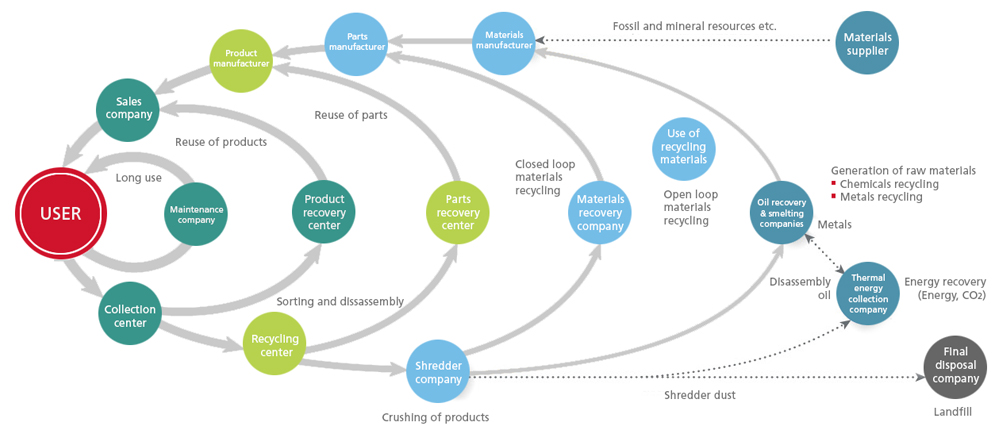The Comet CircleTM
The Ricoh Group contributes to the development of a sustainable society based on the Comet Circle concept.
For the Ricoh Group to become the type of organization we envision, not only does the Group need to realize change towards the creation of a sustainable society but society as a whole also needs to realize such change. In 1994, we established the Comet Circle as the basis to encourage such change. The Comet Circle expresses the greater picture of our environmental impact reduction scheme, which includes not only the scope of the Ricoh Group as a manufacturer and sales company but also the entire lifecycle of our products, including upstream and downstream of our business activities. Being well aware that product manufacturers like Ricoh, because of their involvement in the early phases of a product's lifecycle, can make the greatest contribution to reducing environmental impact, we engage in all business taking into account the Comet Circle.
Flow of the Comet Circle
Each circle in the chart below represents our partners that can help develop a sustainable society. The new resources harvested by the materials supplier from the natural environment (upper right) will be turned into a product through moving from right to left along the upper route, finally reaching the users (customers). The used products will follow the route below from left to right.
Concept of a Sustainable Society: The Comet CircleTM

Identifying and reducing the total environmental impact at all stages of the lifecycle
To reduce the environmental impact throughout the entire product lifecycle, we must identify the degree of impact at each stage, from business process to transportation, by all involved parties—the Ricoh Group, suppliers, customers and recycling companies. Using the Sustainable Environmental Management Information System, which covers all of these stages, we identify the environmental impact to promote development of environmental technology and reuse and recycling of our products, thus striving to reduce the total environmental impact.
Putting priority on inner loop recycling and promoting a multitiered recycling system
Resources have the highest economic value when they are manufactured into products and used by customers. The Ricoh Group puts priority on reusing and recycling products and parts, expressed as the inner loops of the Comet Circle, to return used products to their highest economic value. When a part cannot be reused in a product, we will recycle it as a material. In such cases, we make every effort to recycle the part into a material with a quality as high as possible or to recycle it in the closed loop recycling system, or a system which allows the recycled material to be used within the Group, thereby achieving the highest possible economic value. We also repeat recycling as many times as possible under the "multitiered recycling system" to reduce the need to use new materials and ultimately reduce the volume of waste generated.
More economically rational recycling
In a sustainable society, used products should not be treated as waste but as valuable resources. That is, a recycling system must be developed in which products and money flow in opposite directions in the post-product-use stages as well as the original production and marketing stages. The Ricoh Group, making use of an upgraded design, has established a system to reuse parts repeatedly in production. In partnership with recycling companies, we have been working on quality improvement of recycled resources and minimization of energy used and costs needed for reuse and recycling. This way, we are promoting a more economically rational recycling system that has a smaller impact on the environment.
Reducing the needs of new resources with greater use of recovered resources
Since the initiation of the Comet Circle in 1994, the Ricoh Group has built a system under which used products are recovered and reintroduced into the market, giving way to more efficient use of resources. Given the possibility that some mineral resources may be depleted in the near future, manufacturing styles cannot be said to be sustainable if they require large amounts of resources. The Ricoh Group will accelerate our shift to the new style of manufacturing, whereby the value of resources is maximized through recycling and use of new resources in production is greatly reduced.
Establishing a partnership at every stage
To effectively reduce the environmental impact, close communication and information-sharing among partners is critical. The Ricoh Group strives to reduce its environmental impact in all of its business areas through partnerships with parties at all stages of the product lifecycle. The initiatives include the reduction of environmentally sensitive substances in cooperation with materials and parts manufacturers, improved efficiency in transportation, and green marketing. We also offer solutions to our customers to reduce the environmental impact of their offices. By disclosing information and know-how garnered through these activities and working with local communities, the Ricoh Group helps reduce the environmental impact of society as a whole.
